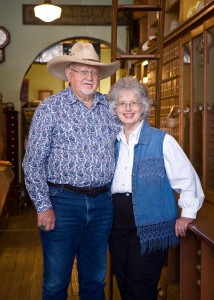A National Park Service researcher is calling. He is working on a feasibility study which is considering the addition of the Western Cattle Trail to the National Park System. The person he is calling is a western author located in rural Kansas.

Last week in Kansas Profile, we met Margaret and Gary Kraisinger, owners of The Old Hardware Store in Halstead. Gary and Margaret are also published authors who have extensively researched the history of the west, specifically the historic Western Cattle Trail.
Gary was raised at Hays and met and married Margaret at Fort Hays State. They became teachers and took teaching positions at Dighton. Margaret taught high school business and English, and Gary taught Kansas history and math at the junior high level while doing graduate work in the summertime.
One day a local rancher approached them and said that he had something he wanted to show them. “One Sunday afternoon, we went out there and the rancher took us out into his pasture,” Margaret said. “We were driving across the pasture and then he turned his wheels sharply, and it was like a washboard. What is that, we asked. `Well, it’s not wagon ruts, but we think it is a cattle trail,’ he said.”
The interest of Gary and Margaret was piqued. Was there an old-time cattle trail that had passed through the region? Gary and Margaret agreed to look into it.
This began a decades-long labor of love. On and off through the ensuing years, they researched the history of the cattle trails. These were the routes on which thousands of longhorn cattle moved north from Texas during the 1800s. Of course, this research started before Google even existed. “We did this research the old-fashioned way,” Margaret said. “We wrote letters and read books and contacted museums and libraries and county clerks.”
With time, they came to several conclusions. One was that a major cattle trail had indeed passed through that rancher’s property. The larger conclusion was that there were different trail systems that evolved before and after the Civil War. There was no simple line on a map, but rather entire systems of splinter and feeder routes leading into trunk lines which reached a variety of destinations through the years. One of these systems was the Western Cattle Trail.
Gary went into the construction business which took him to the Wichita area, where the Kraisingers settled in nearby Halstead. When Margaret retired from teaching, she finally had time to work on the data they had amassed from their years of research. In 2004, Gary and Margaret produced a book titled “The Western: The Greatest Texas Cattle Trail, 1874-1886.” It focused primarily on branches of the Western Trail that went through Kansas and southwestern Nebraska.
“We would go out to do book signings and presentations and people would say, “We’re from Montana, what about us?” Margaret said. Ultimately Gary and Margaret decided to produce a larger, more comprehensive book on the Western Trail system in total.
“It was a team effort,” Margaret said. “I would be writing upstairs while he would be drafting a map downstairs.”
In April 2015, the new book was produced. It is titled “The Western Cattle Trail 1874-1897, Its Rise, Collapse, and Revival.” Of this voluminous book, literally an inch-and-a-half thick in hardcover, it has been said, “No other work has been as comprehensive about the Western Cattle Trail System.”
The National Park Service is now conducting a feasibility study on the possibility of adding the Western Trail and the Eastern/Chisholm Trail to the national trail system. The Kraisingers’ books are being used as supporting evidence.
For more information, go to www.westerncattletrail.net.
It all began with a stop in a pasture near the rural community of Dighton, population 1,223 people. Now, that’s rural.
A National Park Service researcher is calling. As he works on this feasibility study, he is calling on these authors and researchers in rural Kansas. We commend Gary and Margaret Kraisinger for making a difference with their in-depth, thorough research. They are truly helping document and preserve the history of the long-lost cattle trails.
